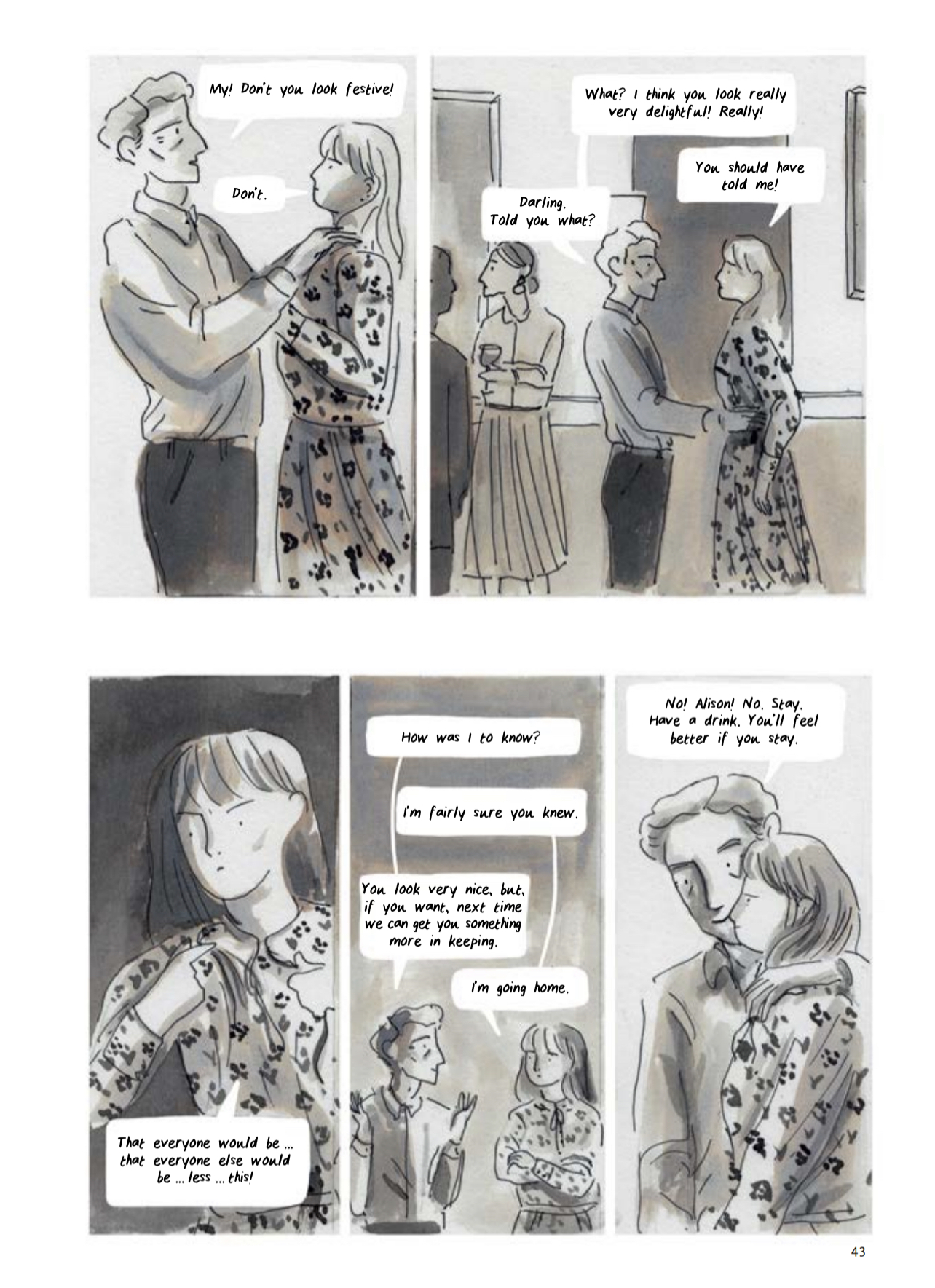Lizzy Stewart’s graphic novel (or perhaps “illustrated text,” as Stewart refers to it in the acknowledgments) recounts the life of Alison Porter from the time she gets married until she is nearing the end of her artistic career. However, her first marriage ends rather quickly, as she leaves her husband to pursue a relationship with Patrick Kerr, a man more than 20 years older than Alison and one of the most important artists of his generation. The beginning of her life as an artist doesn’t seem much more hopeful than that first marriage, as Patrick criticizes everything she produces. However, he sees her as a muse for his work, as the most successful art he creates comes when she sits for his paintings.
One can already see the problems that will come from their relationship, as even Patrick’s friends warn her about his tendency to bring younger women into his studio, then into his bed; he doesn’t seem the type of artist willing to share the limelight. Alison, though, has grown up in Dorset and lived a rather restricted life, so she ignores the obvious warning signs during the early days of their relationship. However, she uses that time to work on her art, building a deep friendship with a sculptor, Tessa Effiong. They encourage one another and inspire one another, even as they know that Patrick’s peers don’t believe they belong. She realizes the truth about her relationship with Patrick, finally leaving him after a fight about his unwillingness to show her work to a curator he knows, even though he said he would do so. That, and a phone call from an Elise that Alison answers, pushes her over the edge.
Stewart’s work covers more than four decades of Alison’s life, becoming a küntslerroman where Alison is the focus, not as a satellite to Patrick’s career, but to the one she slowly but steadily carves out of an unwilling art world. She also has to deal with a lack of understanding from the family she left behind in Dorset for London. Her parents struggle to understand her original decision to move there with Patrick, but also don’t understand her pursuit of art. Her father explains her mother’s struggles with Alison’s choices: “I think she feels left behind. It’s hard. She thought you were happy here, but then you chose something… different.” He does say that they “very proud,” but they also “might not understand it all.” Alison moves past her family’s lack of understanding, as well as Patrick’s wanting her to remain in his shadow, to find her artistic voice and career.

Stewart conveys this development using a visual approach that reflects Alison’s attempts to create a life. At times, Stewart will have several paragraphs of text that read like a novel, with pictures surrounding and following that text, illustrating that part of the narrative, but without any dialogue within them (the “illustrated text” mentioned above). Those images are sketches of Alison’s life, as the reader might expect, but there are also collages of ticket stubs, pictures, and letters or notes Alison sends or receives. In other parts of the book, though, Stewart follows a more traditional graphic novel format with text bubbles and characters inside panels, helping move the story forward. At other times, Stewart will pull back to create a full-page image that looks like a watercolor painting that Alison could have created. It’s not that Stewart is mirroring Alison’s development as an artist, as the different styles don’t progress in a linear fashion, but, throughout the work, Stewart’s artistic flexibility reflects Alison’s ability to continue to grow as an artist.
It would be easy to read Alison’s story as one of a female artist who overcomes the sexism of the art world in the latter part of the 20th century to become a great artist herself. Tessa’s story helps to remind the reader of the racism that also kept out a wide variety of Black artists as well. However, Alison herself sees her life as more complicated than that interpretation allows for. Late in her career, while doing an interview in front of an audience, one of the women in the crowd asks her about Patrick and their age difference, referencing the #MeToo movement. Alison is hesitant to characterize their relationship or her life in that way, while also admitting that he hurt and harmed many people. She also believes she is an artist because of him. She ends by saying, “I can’t answer your question because… the answer is the story of my life. I’m not sure if I can face up to re-writing it at this quite late stage.” Her answer gets to the core of the question Stewart seems to want to explore: what is one to do when the person who helped you become who you most are did so by taking advantage of you and other people as well?
Stewart doesn’t answer that question, if it’s even answerable. Instead, she tells Alison’s story - the story of so many female artists, as well as so many others on the margins. For every Alison who ends up with a successful career, there are many others who didn’t. For every Alison who could overcome the men who take advantage of her, there are many others who couldn’t. Stewart presents a nuanced story that forces the reader to ask the questions and, hopefully, to see the power structures that still exist in the art world (and elsewhere) for what they are. Alison might not be able to disentangle her life from those people in power, but Stewart’s question should help the reader begin the work of doing so.










